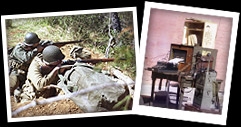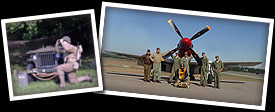Now that you have decided to start re-enacting the WWII GI, you need some web gear. But what color? Some people will tell you that everything, absolutely, MUST be khaki. But, this is not entirely true. Khaki was the earlier color, but you need to break it down into the time, theater, and item of equipment.
When did the production of khaki webbing stop, and green webbing begin? The answer to this question will help put everything in perspective. The US Army did NOT decide on August 10, 1945, to switch over from khaki to green webbing to make it easy for collectors in years to come. Get that myth out of your head. Actually, the US Army was already using some darker green colored items even before WWII, if you stop and take a look at the canvas used on vehicles. And the re-inforcing material used on the M1942 paratrooper uniform was clearly green in most cases when applied. So even the Quartermaster Corps was not obsessed with everything being "khaki". But with regard to web equipment, some items can be found dated as early as 1942 made of OD green material. I have seen several items dated 1943 which are green, or partly green (items made of a mix of khaki and green material are commonly called "transitional" and are under-appreciated in the hobby and among collectors). By the time 1944 rolled around, a great many items were being made from green webbing, as the khaki was being phased out. However, some khaki material remained and I have seen items dated 1945 made of khaki, and I have even seen a M1928 pack in khaki dated 1946!
What about the different shades of khaki and OD green? This is a question bound to trip some people up. There were always some subtle variations in shade due to dye lots, as different manufacturers and other factors (like dyeing temperature and quality of the water used in dyeing) were inevitable when an entire nation began making these items. Early or pre-WWII webbing was often of a more plain tannish khaki, and in 1940-1942 the emergence of a khaki with a slight greenish hue was introduced (I have heard this called the pea-green khaki) and has been recognized as OD#3. In some cases, it is rumored this greenish hue was brought about by the addition of a chemical additive in the dye which was to help make the webbing more mold and mildew-resistant, though I do not have data to substantiate this. When OD green was introduced, it was of a medium-to-dark green, officially called OD#7. Sometime (probably in 1944) the first appearance of a darker OD green #7 came about, but this is not seen on a large scale until after the war. This later version of OD#7 was also had more of a dark earthy tone of green than the earlier OD#7 which was more greenish with little trace of brown hues. One should also be aware that the wartime OD green faded to a shade not always easy to distingush from dirty khaki.
When to wear green or khaki? Now that we understand that OD green webbing DID exist to some degree, we need to decide when it is appropriate. In the next section we will break it down into some of the individual items made in "khaki" (OD#3) and "green" (OD#7). It is important to note that certain elite troops, because of their role, were often issued with newer and more modern equipment first. Also, depending on when a unit was last in the States (being equipped before going overseas) has something to do with this issue as well. Are you going for a impression for North Africa 1942 or Sicily in 1943? Then, you probably need all khaki web gear. Trying for April 1945 in Germany? You will need a bit of OD green webbing. Once in combat, troops that survived became aware of how obvious their coloration made them to the enemy. If a GI was wise enough to realize that turning his M1941 field jacket inside out made him darker and less conspicuous, then he would probably have accepted green webbing if he could get ahold of some. And never forget the individuality of the soldier, that is also a big factor! I have heard several accounts from veterans that they grabbed the "newer" equipment (in some cases they mention it was green) in order to have the latest thing, or to have what they thought was newer and better than what everyone else had.
How about specific items? We now need to look at some individual items of equipment to decide if it is correct to wear it in green or khaki:
- The assault vest? This one needs to be addressed
for all you D-Day fans. Contrary to popular belief and contrary
to the truth as presented in popular Hollywood movies, MOST OF THESE WERE OD GREEN.
Not many were made in khaki. These were almost all manufactured
in 1944, and by then green was the standard color desired by
the US Army Quartermaster Corps. Khaki ones did exist, but
not on the scale we see them today. Looking through photos and
surviving originals shows the majority to be OD#7 green. It is
also worth mentioning that records indicate that the 2nd Ranger
Battalion was issued these before D-Day, but all of them were
OD GREEN. And, all of these were limited to officers and
senior NCO's.
- The cartridge belt? The standard issue M1923 cartridge
belt was one of the highly-produced items of the war. And as such, they
came in many different shades of color, and even in 'transitional' patchwork
belts. The Quartermaster had a good supply of these in khaki even until
the end of the war, but some green ones were issued. There was more of
a chance of a green one being issued to a more elite unit, or one that
left the States for Europe after September 1944 (For example, there are
a few clear photos of men in the 82nd Airborne just before jumping into
France on D-Day showing them wearing dark colored belts which in black & white
match the canvas re-enforcing on their jump suits). My opinion is that
for any impressions of the Market-Garden time period and later, it is
safe to have 10-15% of the members of a unit with OD green belts.
However, they should be the exception and not the rule. M1936 "pistol" belts
should follow the same rule, with 10% maximum of these in a unit. The
BAR belt should be khaki in almost all cases.
- The pack? If you're an infantryman, you have the M1928
pack. I have yet to see one of these packs made in OD green, though I
am sure some do exist. Virtually everyone with one of these packs should
have a khaki one. However, if you use a pack tail, many of them were made
green in 1944. For those of you using a M1936 Musette bag, most of these
also were khaki, though some OD green ones were made and released for
use. I think having 10-20% in a unit of these, after 9/1944, is reasonable.
For Operation Varsity in 1945, the number can go higher.
- The shovel cover? If you have a M1910 T-Handle shovel,
you should have a khaki shovel cover for it (I have seen an OD green one,
which is in my collection, however it is not common to find these).
The M1943 shovel was introduced in time for them to reach elite troops for the D-Day invasion. The majority of M1943 shovel covers are OD#7 GREEN. This is true even in 1943, the first year of production. Solid khaki covers are exceptionally rare, as most khaki ones have at least OD trim around the edges. For those of you with one of these shovels, 80-90% or more of these should have OD green covers.
- The canteen cover? Canteen covers were mass-produced,
and most of the ones in use were khaki. But, again, it is not unusual
to see a green one here and there, like the green cartridge belts. Also,
since the canteen covers got wet more frequently, they sometimes faded
a little faster. Some covers that look khaki are actually faded green.
- How about gas mask bags? If you are talking about a
amphibious waterproof gas mask bag as used on D-Day, almost all of these
were made with OD green web straps. A few were made in khaki, but
these were the exceptions. I'd say the majority were clearly made with
straps of OD green, just try to find an original with khaki straps and
that helps put it in perspective. The "lightweight" gas mask
bag was made in both khaki and green, and also in transitional colors.
I have seen a lot of these that are partially or completely green, though
solid khaki ones are not uncommon. But there should be a good amount of
green on these among members of a unit.
- First aid bandage pouches? This was one of the most
common items of field gear both then and now. The abundance of these today
in khaki is a testimony to their plentiful supply in WWII. I would recommend
this item be khaki for any WWII impression, at any time.
- Helmet chin straps? With a good supply of
reproduction khaki chin straps, we are without excuse these days to have
a khaki one. Green ones did begin to appear late in the war, but apparently
not to a large degree.
- Grenade/ Ammo bags? Most of these that are found tend
to be 1943-1944 dated and are transitional - with both khaki and green
parts. Commonly found ones have a khaki body with OD green trim. Of course,
solid khaki and solid green ones were made and used. But this clearly
does not have to be 100% khaki to be correct.
- Other pouches, etc? Many of us have seen Carbine ammo
pouches in khaki and green, and it is my opinion that a having a few green
ones is correct. But, most Carbine slings tended to be khaki until after
the war. The small pouch for the 'grenade launching sight' for the M1
has been OD green in every example I have ever seen (but personally I
would not bother with that item anyway, there is a reason every one you
find is unissued). Compass pouches tended to be primarily OD green, as
were the jungle first aid kit pouches. The web top of an M8 scabbard was
most often OD green.
I realize that this list will not be agreed to by everyone, and that is OK. These are just some conclusions I have arrived at based on my own study, but the study is ongoing and new discoveries help uncover more truth. But the key point is that you understand that not everything was made in khaki and only khaki, and some items were more often OD green than khaki. So next time you're at a swap meet and someone throws out a box of green webbing, perhaps you can make a dash to grab some up - just like many of the actual soldiers did in order to help blend in better to the surroundings.


